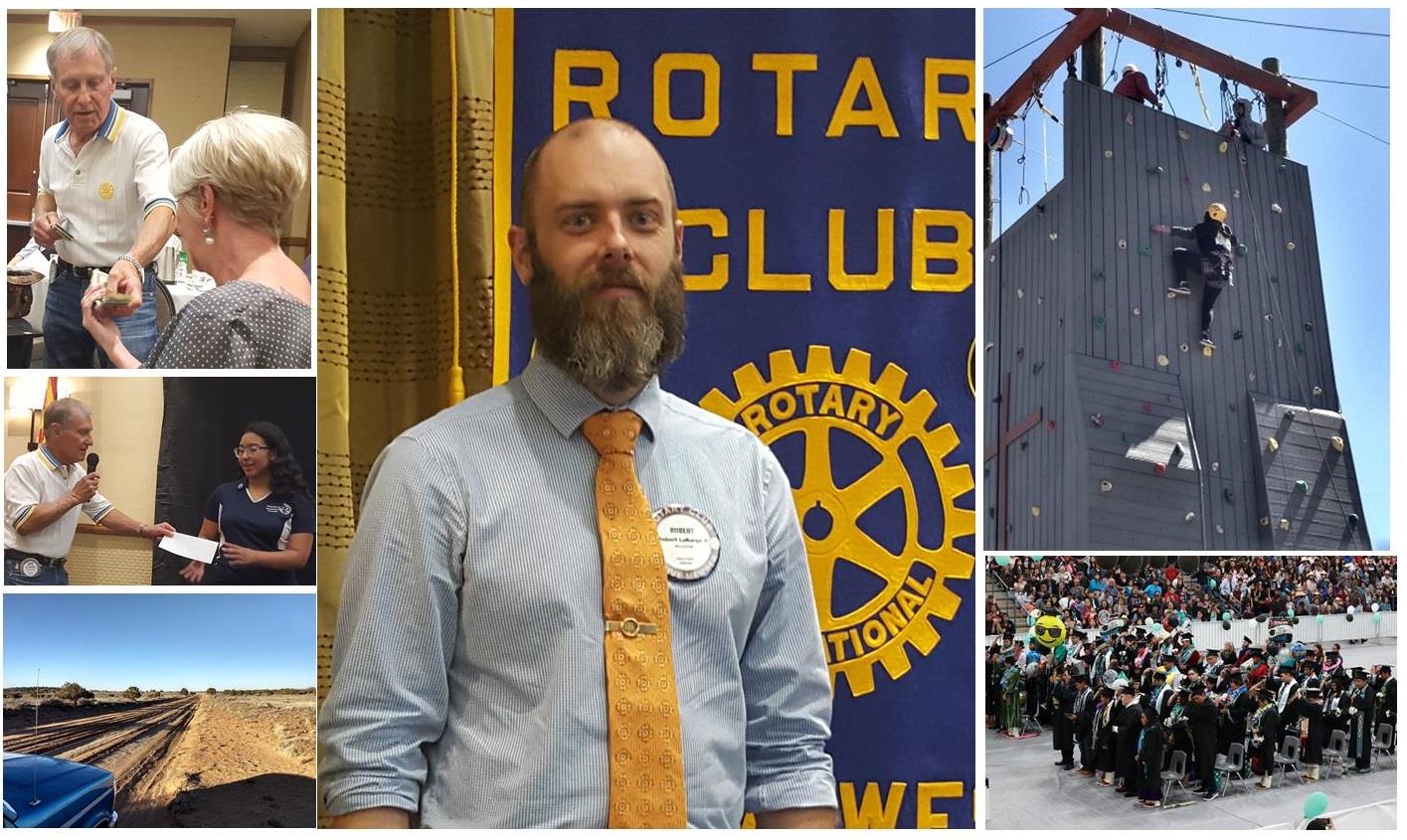 Dan Coons, who will serve as Mesa West Rotary Club President in 2020-21 opened the meeting, asking Dr. Ron Thompson to offer the invocation. He called on John Pennypacker to lead the Pledge of Allegiance. John announced that on June 6, 1942, the war department founded Organic Army Aviation, and on June 6, 1944, the D-Day invasion at Normandy was bravely carried out. On day 1, 1,913 allied soldiers were killed, and 2,501 American soldiers lost their lives. Twenty of those boys were the boys of Bedford, Virginia, causing that community to suffer the highest per capita loss in World War II. The national D-Day Memorial is located in Bedford. After providing these meaningful lessons in history, John suggested all join him in the pledge with appreciative gusto.
Dan Coons, who will serve as Mesa West Rotary Club President in 2020-21 opened the meeting, asking Dr. Ron Thompson to offer the invocation. He called on John Pennypacker to lead the Pledge of Allegiance. John announced that on June 6, 1942, the war department founded Organic Army Aviation, and on June 6, 1944, the D-Day invasion at Normandy was bravely carried out. On day 1, 1,913 allied soldiers were killed, and 2,501 American soldiers lost their lives. Twenty of those boys were the boys of Bedford, Virginia, causing that community to suffer the highest per capita loss in World War II. The national D-Day Memorial is located in Bedford. After providing these meaningful lessons in history, John suggested all join him in the pledge with appreciative gusto. Dan thanked Lola McClane for serving as greeter making members and guests welcome for the meeting.
Guests
Don LaBarge introduced his office manager and niece, Shannon. Interact Past Treasurer, Sandra Franco was introduced. Steve Ross introduced John, a past member of Mesa West. Frank Rosenberg introduced Alex Hajdys, who will be interning with Frank this summer. Our inbound Youth Exchange Student, Caio, was able to visit. His exchange will soon be over, so members were glad to have another chance to enjoy visiting with him. Former Rotarian Steve Pepper now resides in our area. When he was in Rotary, he lived in Georgetown, Delaware and is a former mayor of that city.
Scholarship Presentation
Chuck Flint invited Sandra Franco to the podium area. Sandra has been active in the Interact Club at Westwood High School where she recently graduated. Chuck wanted to present Sandra as a recipient of a $1,000 Mesa West Rotary Foundation scholarship to attend Arizona State University. He asked Sandra to share some specific information about herself. She graduated 11th in her class with a 4.935 grade point average. She said her first time attending a Mesa West Rotary Club meeting was on youth day after she attended RYLA. Since then, she has served the Interact Club as Treasurer, served on the Interact District Council and has been selected to be an Ambassador on the Interact District's Crutches 4 Africa mission. She and the rest of the team of Advisors and Ambassadors will be leaving for Kenya in a few weeks. At ASU, she plans to major in global studies. She wants to be a foreign service agent.
Drawings
Pam Cohen collected $33 because she was holding the ticket drawn. The larger accumulating winnings, now up to $104, will continue to grow, because Pam's luck did not continue, as she drew the two of spaces from the dwindling deck. Warren Williamson was present to win the $5 attendance drawing prize when his badge number was drawn.
Happy Bucks
Dr. Ron Thompson served as Sgt. at Arms collecting first from Pam Cohen who was happy to see former member, John. Frank Rosenberg, who had been a host father to Caio, what happy to get to see him at the meeting. Colleen Coons was happy to see her Rookie husband officiate over the meeting. Bob Zarling had spent some time as a volunteer at the Mesa Food Bank. He was happy to report six or more volunteer youth groups were also there working. Visitor Steve Pepper was happy to be at the meeting.
Chuck Flint was happy to share the following:
"On the night of June 5-6, 1944, 815 C47 type (DC-3) transports were dispatched in two waves to drop paratroopers artillery pieces, and vehicles, as well as to two infantry-filled gliders, behind enemy lines in Normandy on the French coast. The aircraft took off from 20 airfields scattered across Britain in a sequence choreographed to unite all aircraft into a single stream crossing the Channel at 140 MPH. Seventy-five years ago, young American paratroopers stood at that open door with engines roaring in their ears, and the fate of freedom in their hands. The red jump light in the compartment turned to green, and history changed course.
"The Allies landed more than 156,000 troops on five code-named beaches (Utah (23,250), Omaha (34,250 - includes 15,500 airborne); Gold (B - 24,970), Juno (Can - 21,400) and Sword (B & Fr - 28,845) in Normandy (includes 7,900 airborne). 73,000 of those were American. Casualties: Canadian - 946; Brittish - 2,700; American - 6,603. Killed: 2,499 American; 1,914 Allied.
"By midnight of June 6th, all beaches were secure."
Dick Myren contributed honoring Rod Daniels' tradition of being happy to be a member of Mesa West. He was also happy to have finally had two consecutive days of 100º+ weather. Collen Coons was proud her father was a Ranger. Dan Coons was happy to have recently had a break (in Hawaii) from keeping Caio.
Pam Cohen had one additional way to honor D-Day. She showed a video written and performed by D-Day Veteran Jim Radford who was a 15-year-old galley boy on the day he became a man. CLICK HERE to view the video.
Announcement
Pam Cohen announced that the annual changing of the guard celebration would take place at the Hilton during an evening social event on Thursday, June 27. There will be no regular meeting that day.
Program
Don LaBarge was happy to introduce his son, Dr. Robert LaBarge, who is a 12th grade English/Language Arts teacher and school leader at the high school located on the Navajo Nation in Piñon, Arizona.
Robert began his presentation explaining that life on the Navajo Reservation is very challenging for teachers there. It was his first year teaching high school as well as his first year teaching on the reservation. He also explained that local residents quickly recognize visitors when they pronounce the name of the community of Piñon. Locals pronounce it "Pin Yawn" with the emphasis on the second syllable. Outsiders pronounce it "Pin Yun" with the first syllable emphasized.
The business community consists of Bashas, Subway, Pizza, Laundromat, and Conoco. Those five businesses are the entire business community.
It is very remote and in the center of the reservation. He has to drive 19.3 miles of dirt road, which is often badly rutted. It takes two hours or more to get to any community of substantial size. School bus routes include many dirt roads. In addition to snow days, they also have mud days. It is a logistical challenge to get kids to school.
The entire school system is all on a single campus. Standardized Arizona Department of Education test scores when he started were "F." They are now "D" Robert knows they can get to "B" and hopes they can get to "A." Student scores look like a standard bell curve. Robert believes the bell can move if students begin to know what their opportunities might be beyond the five local businesses. There were 270 students in the high school. The prior year they had a substitute English teacher the entire year.
The school system is severely resource deprived teacher-wise. Money is not the problem. They have excellent facilities They need teachers who will stay and parents who care because they understand education can bring a better future for their children. Every teacher is provided a house at a cost of only $300 per month. The retention challenge in retaining quality teachers is mostly due to the remote location. Teachers can experience a very real sense of loneliness and desperation.
A daily struggle is that "doing school" is different on the reservation. It is hard for students to develop good study habits when they spend hours on a bus getting to and from school. Students can recite factual answers very well, but they haven't learned how to effectively analyze and think about what they know. Only 20% of graduates go on to college. One of Robert's fellow teachers was a former graduate of the local high school. He was the only member of his class to get his B.A. He teaches art.
Graduation from high school is a very big deal. There were only sixty in the graduating class, but over 2,000 attended the graduation. Robert's truck was decorated and in the homecoming parade. The school has an impressive color guard - so impressive they are often invited to events off the reservation. Robert believes there is great potential.
In answer to a question, Robert stated that most of the teachers are women. When asked if that was a problem, Robert stated it absolutely was not. The Navajo culture is a matriarchal culture with unique dynamics.
School busses arrive at school about 7:30 AM. Some children have been picked up as early as 6:00 AM. Some of the busses are 4-wheel-drive and raised (because of the rutted roads). When asked how the youth interact socially, Robert said "they don't." School is their social interaction. About half of the students live in housing withing walking distance of the school. Those dorms are for students who live really far from the school.
Three of his students joined the military with decent scores on the Armed Services Vocational Aptitude Test (ASVAT). The military is competing with colleges - they want the best and brightest.
When asked about average family income, robert did not know. He guessed it is low as two-parent homes are rare and because they are so remote, there is no active casino drawing outside money that would benefit the households of his students.
The student photographed on the climbing wall at RYLA is Naanibas Ayes, one of the students sponsored by Mesa West to go to RYLA. He told about the challenges of getting the students to be able to get permission and emotional support from their family to go to RYLA. Sandra Franco was a Junior Counsellor at RYLA and spoke briefly about how she had personally witnessed how transformational the experience was for the Navajo student delegates.

